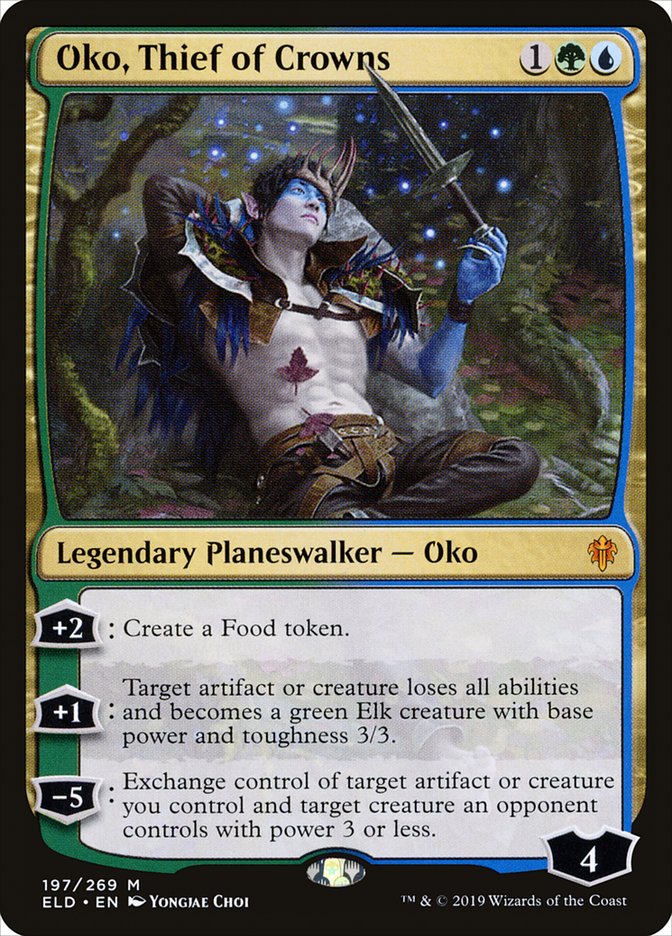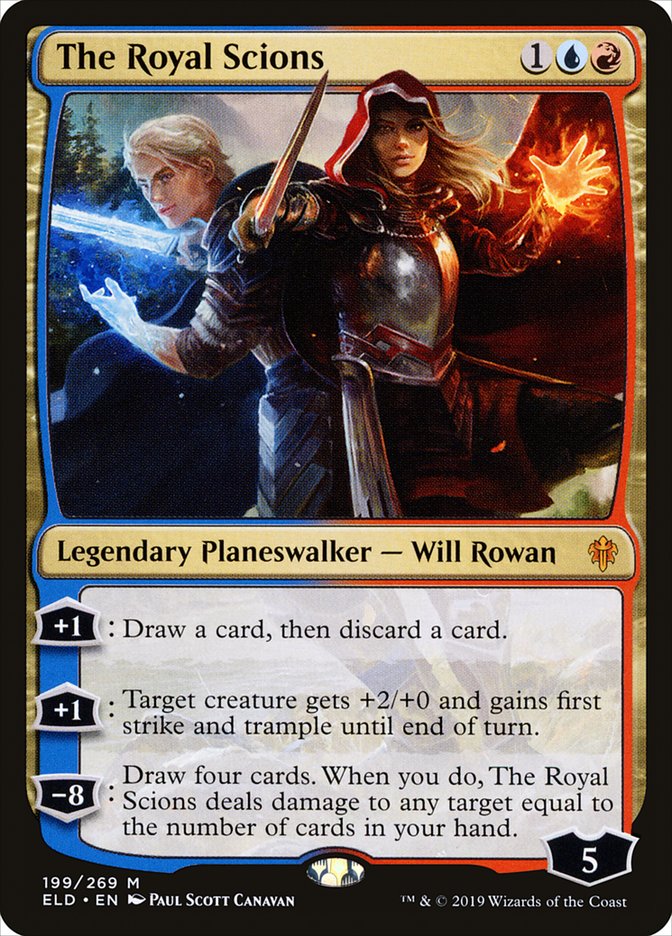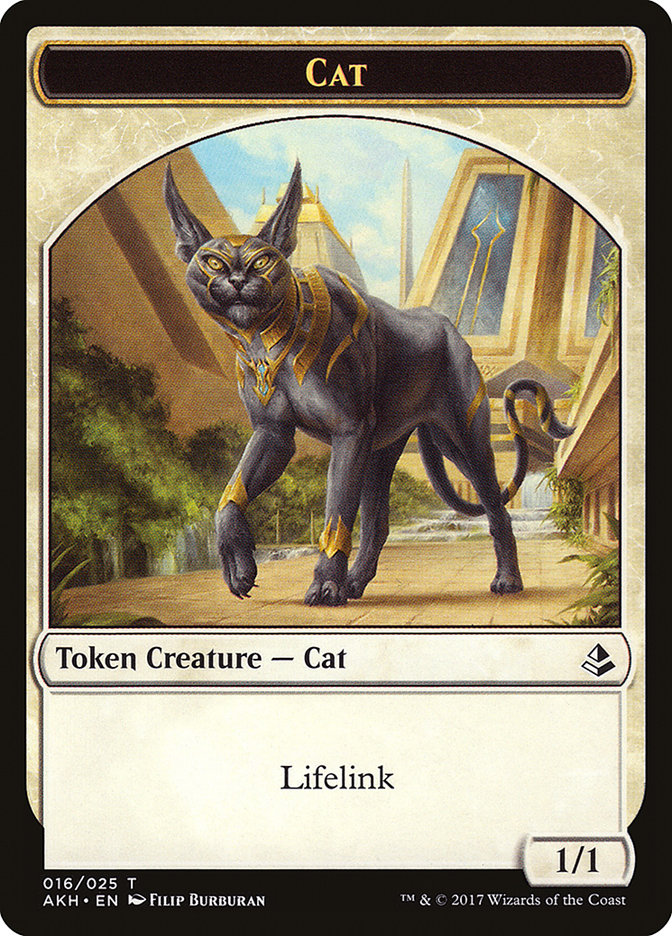I recently had the pleasure of playing in the Early Access Streamer Event held on Magic Arena featuring Throne of Eldraine. Thanks again to Wizards for the fully stocked account!
Today we’re going over everything I learned while playing in the event itself, and also my impressions of Standard moving forward. You’ll be getting my general opinion of how the format will play out, the top cards that impressed me, and also some of the decks I’m working on. Let’s get into it!
So to kick things off, let’s first talk about how I think Standard’s going to function. Hyper-aggressive strategies just won’t succeed. Long-term, anyway. That doesn’t mean some of the aggressive cards like Knight of the Ebon Legion won’t be playable, or a specific strategy won’t be good for a given week. It means this format will not be dominated by these types of strategies. It just doesn’t seem possible, given how easy it seems to fend off small-ball aggressive decks.
Maybe there’s a Mono-Red deck that cheeses opponents out with Torbran, Thane of Red Fall, but even that seems easily beatable given the high density of anti-aggro tools out there.
Creatures (24)
- 4 Chandra's Spitfire
- 4 Runaway Steam-Kin
- 4 Tin Street Dodger
- 4 Scorch Spitter
- 4 Fervent Champion
- 4 Torbran, Thane of Red Fell
Lands (21)
Spells (15)

This doesn’t mean the format’s slow, though. In fact, it seems like this format will be exceptionally fast relative to the previous one. It’s just that playing quick creatures and attacking with them isn’t exactly what this format is going to be about. There are just too many early defensive cards that can easily beat cheap creatures, and also a ton of over-the-top strategies that make it difficult to fight through.
Here’s a perfect example.
Creatures (14)
Planeswalkers (3)
Lands (22)
Spells (21)

This is an unrefined list of Izzet Phoenix that I used on Tuesday. I’m unsure on many things when it comes to this archetype, but one thing I’m sold on is that Irencrag Pyromancer is amazing. It has four toughness, which lets it block a ton of aggressive creatures, and also a highly relevant ability against them. This card alone will make it very difficult for early aggressive decks to do what they want to do. There are many more examples of this, but we have to move on to make sure we cover everything we need to today.
Now this doesn’t mean that being proactive strategies are dead. In fact, I’d guess most decks will be proactive-facing, similarly to how the previous Standard functions. Cards like Nissa, Who Shakes the World; Teferi, Time Raveler; Hydroid Krasis; Field of the Dead; and Nightpack Ambusher all still exist, and Throne of Eldraine dumped a ton of powerful payoffs and enablers on us to sift through.
These are just the ones I got limited experience with. I still have no clue how good cards like Harmonious Archon, The Circle of Loyalty, or The Cauldron of Eternity are. I just know that the format has a ton of powerful cards that require decks to be built in a very specific way to function best.
The Soul of Competitive Magic
And that’s where I’m pulling out my soapbox for a hot minute, and derailing this article for an important message. Not completely, I guess, as this does pertain to Standard, but there wasn’t really a great place to shove this in, so I’m doing it “stream of consciousness” style.
I saw a lot of wild things on Tuesday during the Early Access Event, but the craziest was someone saying, “Competitive Magic isn’t about innovation.” Now this wouldn’t have meant anything to me if I haven’t seen similar posts over the years, but I have. I’ve also seen countless people complain that their fun decks aren’t good enough, and it has gotten oh so tiresome always seeing people constantly scoff at whatever’s the best card in Standard.
“Ugh, another Nexus opponent!”
“Teferi players are the worst.”
“Why is Golgari so good? I’m so sick of it!”
Okay, fine, that last one wasn’t real, but the others have been said to me in Twitch chat about 100 times. I’m sick of it, because I don’t think people truly understand what Standard, and ultimately Constructed Magic, is.
While there’s more than one way to sleeve a Cat token, that doesn’t mean they all work in Standard. Just because something is cool doesn’t mean it can be good, and the reasons why it isn’t good might not have fixes. Along the same vein, things that are good aren’t automatically boring or ruining the game. There’s still a ton of innovation and exploration that goes into tuning lists.
Standard is about two things: card advantage and interaction. You’re trying to gain as much card advantage as you can while also trying to interact with your opponent’s most important resources. It’s up to you which ones you value, and how much you choose to interact with them, but that’s all there is. You are in constant pursuit of the right combination that lets you interact the perfect amount with the largest percentage of the metagame as you can, while also doing your best to insulate yourself from their interaction.
This is often a boring and thankless job if you’re not a public figure. If you have a bad event, it feels like you wasted a ton of time trying to perfect the best “Esper Hero” list, even though it was only four cards off what Brian Braun-Duin played in the last Fandom Legends event. By no means is it as exhilarating as building the first Cookie Monster Combo deck and being praised for your cool new brew.

Look, there’s no profound end to this rant. Maybe this all makes me come off pretentious. I don’t really know. I just get sick of the idea that competitive Magic is boring when that couldn’t be further from the truth. It takes a ton of out-of-the-box thinking to come to conclusions that involve predicting the metagame, balancing interaction against every deck, and ultimately having contingency plans for the field and how they plan to interact with you. Competitive Magic is rarely about finding the next hot deck, and is usually about how many Desparks your 75 should play. Personally, I find that really cool.
Anyway, how many Desparks should we be playing with right now?
Return to the Fire
Both of these cards really impressed me as they didn’t seem as slow as I thought they would. I started my stream off with Five-Color Fires, designed by Star City Games’s own Bryan Gottlieb.
Creatures (14)
- 1 Knight of Autumn
- 1 Deputy of Detention
- 1 Tolsimir, Friend to Wolves
- 3 Niv-Mizzet Reborn
- 4 Gilded Goose
- 4 Fae of Wishes
Planeswalkers (3)
Lands (25)
Spells (18)

Clearly this sideboard was designed for the best-of-one Early Access Event format, so that would have to change, but that’s not important right now. I mean, I guess it is, since I have to figure out my decklist for Fandom Legends, but for the masses it’s too early to get caught up in sideboards. For now we just have to take a look at the core strategies and see if there’s something there.
After playing with this deck, I can say without a doubt that there’s something there. Fires of Invention is an exceptionally powerful card that allowed for some extremely stupid turns. The card doesn’t even need to be in a five-color deck to be worth it. I played against William Jensen piloting this VTCLA deck, and it had a lot of cool things going for it.
Creatures (19)
Lands (26)
Spells (15)

This Fires of Invention deck does something Bryan’s did not, which is utilize mana when the four-mana enchantment is on the battlefield. Wildborn Preserver and Cavalier of Flame are amazing with Fires of Invention, as you have the ability to dump all of your mana into them. These Niv-Mizzet variants are a lot of fun and quite powerful, yet have no mana sinks outside of Gilded Goose, which isn’t enough.
I honestly think Fires of Invention is going to find a great home for these first couple of weeks in Standard, but odds are it’ll lose some wind once people start packing enough interaction. The issue, though, is simply killing it doesn’t stop the deck from doing its thing. It’s just a bonus to have on the battlefield, so who really knows what’s going to happen. I just know I want to register Despark, as it’s one of the only answers out there for Fires of Invention and The Great Henge.
I guess there’s Assassin’s Trophy, but I hate giving my opponent lands!
That’s what’s so tough right now. I feel like I grasp how this format’s going to play out, but it’s still way too early to know exactly what to do about it. There are two extremely powerful three-mana planeswalkers in the format, a slew of midrange cards that are very good, and then curve-topping cards that are beyond impressive, like The Great Henge. On top of all of this, there’s Brazen Borrower, which I believe has the most potential for being the best card in the set once we look back on Throne of Eldraine, but the only shell I’ve tried it in is Simic Flash.
Creatures (21)
- 4 Frilled Mystic
- 4 Spectral Sailor
- 4 Nightpack Ambusher
- 4 Brineborn Cutthroat
- 1 Wildborn Preserver
- 4 Brazen Borrower
Planeswalkers (1)
Lands (24)
Spells (14)

Nothing jumped out at me when I was playing this deck. Oko, Thief of Crowns seems like a strange one-of, but I wanted to try it out, and it did win me a game. I also am unsure of the mana, but didn’t want to go too far in either tapland direction. It’s also nice to play Temple of Mystery on Turn 1 and Fabled Passage on Turn 4. A mixture might simply be best, but it’s still too early to tell.
Brazen Borrower was very good in this deck, but I’m not sold on the archetype in general. It felt fine, but still had all the same issues it had in Core Set 2020 Standard. Sometimes you lose to the die roll and never really get a chance to be in the game. After I get a ton of games under my belt I’ll have percentages, but right now I have to go off feel, and it doesn’t feel great. Fine, but not something I think takes over the format.
Ultimately, though, I think this set is awesome, and I had a ton of fun playing Throne of Eldraine Standard on Magic Arena this past Tuesday. Starting Thursday I’ll continue to get some practice in, and I hope to break Oko wide open, as that card is fantastic! I’ll see you all next week with some tuned decks, as I’ll be a week into Mythic Championship V testing. Hype!






